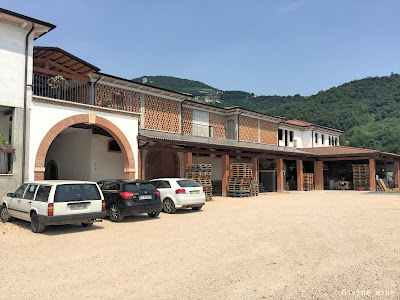 |
| High quality Valpolicella is hill-grown. |
Too steep! Our little
rental car protests agreeing only to the first gear as we start climbing up the home hills of
quality Valpolicella. Here the traditional divide between classico and
non-classico wine zones doesn’t always indicate respective quality difference.
Rather, quality is essentially a function of two things: restricted
yields, and grapes grown in the hills instead of the plain. With these points
in mind, we continue travelling at a steep angle in our heroistic, high-pitched
vehicle.
Finally, we reach our
destination: Tommaso Bussola’s winery close to Negrar in Valpolicella
classico. The car now parked and silent, one can only hear vine leaves
swishing. Peaceful and filled with roses in full bloom, this landscape is the
obvious home for the concentrated, powerful, yet floral Amarone.
But let's not hurry, dear vinous friends. Before we
get to the winery visit at Bussola, I feel a need to cover some basics. Hence,
this post is about the winemaking techniques typical of Valpolicella area, and
will later be followed by posts about Amarone, and Tommaso Bussola winery.
Three
styles of winemaking in Valpolicella
Valpolicella
red wines are made with three distinct techniques. First, there is Valpolicella
normale; second, Recioto and Amarone
made of partially dried grapes; and third, ripasso
wine. The ordinary Valpolicella is made along the lines of any normal red
wine with relatively short maceration with fresh grape skins. The resulting
product may be anything from a structured premium wine from grapes grown in the
hills or a light, fruity and uncomplicated bulk wine from the plains.
Although the
bulk wines from Adige river valley plains have harmed Valpolicella’s
reputation, it has retained its greatness through Recioto, a sweet and bitter
red reminiscent of fortified wines, and especially through Amarone, currently a
star product of the area. Recioto and Amarone’s exceptional concentration is
achieved through partially drying the grapes before winemaking. While this appassimento technique results in a
third of the water volume being evaporated, all the goodness in the grapes is
concentrated - especially sugar and extract. The grapes for Amarone are dried
in this manner atleast for four months, and Recioto grapes even longer. This
takes place in special drying rooms usually built in the lofts of the wineries.
The beautiful, lacy brick structures typical to Valpolicella wineries hence serve
a crucial function besides being aesthetic.
 |
| The brick lace drying room walls of Bussola winery. |
Once the
grapes are sufficiently dried, they are crushed and the fermentation begins.
Challenging the fermenting yeasts, the must has a high sugar concentration.
Although sugar is just what yeasts need to function, a very high concentration
of sugar can paradoxally hinder the yeast or even kill it. Whether the
fermentation is completed depends on the specific strains of yeast involved.
Strains better equipped to tolerate high levels of sugar and alcohol can
ferment the wine to dryness, resulting in Amarone. If the fermentation comes to
a halt at en earlier point, residual sugar is present and the wine produced is
Recioto. Actually, it is speculated that Amarone (amare, ital. for bitter) was originally Recioto gone wrong! Both
wines have a high alcohol content due to the high sugar levels at the start of
fermentation. Legally it is required that Amarone has a minimum of 14 %
alcohol.
Ripasso,
the third technique, innovatively utilises the grape skins left behind from
Amarone fermentation. These skins full of power, flavour and phenols are used
to upgrade Valpolicella normale by taking this ordinary, often relatively light
red in contact with the Amarone skins for second fermentation. This way the resulting
ripasso (re-passed) wine, although still lighter and less alcoholic, receives more power
and body, and communicates the aromatic complexity of Amarone.
In my next
post I’ll still be looking at Amarone in more depth. After that, I’ll take you
to meet the Bussolas. Cin cin until then!
 |
| Valpolicella normale waits for ripasso in stainless steel. |
No comments:
Post a Comment